Book contents
- Frontmatter
- Dedication
- Contents
- Preface
- Acknowledgments
- Abbreviations
- Notation
- 1 Introduction
- 2 Large MIMO systems
- 3 MIMO encoding
- 4 MIMO detection
- 5 Detection based on local search
- 6 Detection based on probabilistic data association (PDA)
- 7 Detection/decoding based on message passing on graphical models
- 8 Detection based on MCMC techniques
- 9 Channel estimation in large MIMO systems
- 10 Precoding in large MIMO systems
- 11 MIMO channel models
- 12 Large MIMO testbeds
- Author index
- Subject index
- References
1 - Introduction
Published online by Cambridge University Press: 18 December 2013
- Frontmatter
- Dedication
- Contents
- Preface
- Acknowledgments
- Abbreviations
- Notation
- 1 Introduction
- 2 Large MIMO systems
- 3 MIMO encoding
- 4 MIMO detection
- 5 Detection based on local search
- 6 Detection based on probabilistic data association (PDA)
- 7 Detection/decoding based on message passing on graphical models
- 8 Detection based on MCMC techniques
- 9 Channel estimation in large MIMO systems
- 10 Precoding in large MIMO systems
- 11 MIMO channel models
- 12 Large MIMO testbeds
- Author index
- Subject index
- References
Summary
The practical demonstration of the vertical Bell laboratories layered space-time architecture (V-BLAST) multiantenna wireless system by Bell Labs [1], and the theoretical prediction of very high wireless channel capacities in rich scattering environments by Telatar in [2] and Foschini and Gans in [3] in the late 1990s opened up immense possibilities and created wide interest in multiantenna wireless communications. Since then, multiantenna wireless systems, more commonly referred to as multiple-input multiple-output (MIMO) systems, have become increasingly popular. The basic premise of the popularity of MIMO is its theoretically predicted capacity gains over single-input single-output (SISO) channel capacities. In addition, MIMO systems promise other advantages like increased link reliability and power efficiency. Realizing these advantages in practice requires careful exploitation of large spatial dimensions.
Significant advances in the field of MIMO theory and practice have been made as a result of the extensive research and development efforts carried out in both academia and industry [4]–[7]. A vast body of knowledge on MIMO techniques including space-time coding, detection, channel estimation, precoding, MIMO orthogonal frequency division multiplexing (MIMO-OFDM), and MIMO channel sounding/modeling has emerged and enriched the field. It can be safely argued that MIMO systems using 2 to 4 antennas constitute a fairly mature area now. Technological issues in such small systems are fairly well understood and practical implementations of these systems have become quite common.
Information
- Type
- Chapter
- Information
- Large MIMO Systems , pp. 1 - 15Publisher: Cambridge University PressPrint publication year: 2014
